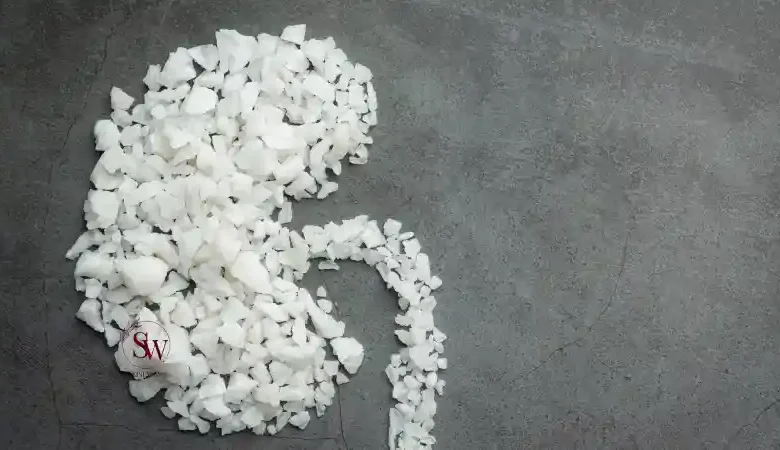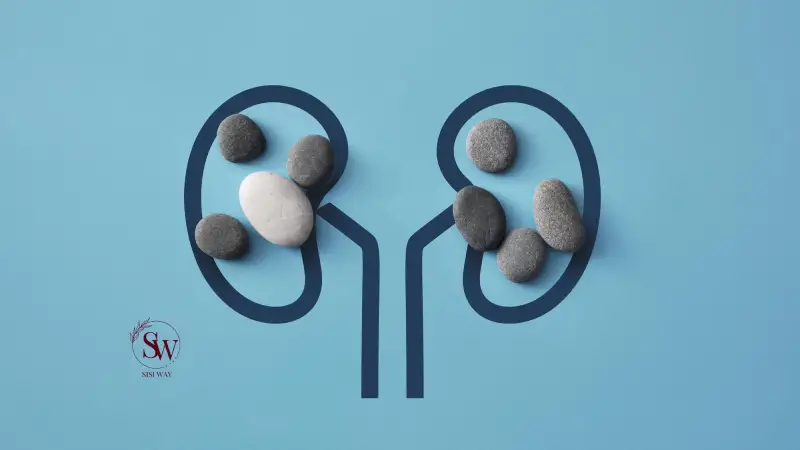Calcium Oxalate Kidney Stone

Calcium Oxalate Kidney Stones
Kidney stones are a common urological condition that affects millions of people worldwide and unfortunately, kidney stones in women are more common than in men, and we see many women struggling with this issue. Among the different types of kidney stones, calcium oxalate stones are the most prevalent, accounting for approximately 75% of all cases. In this article, we will delve into the causes, symptoms, and treatment options for calcium oxalate kidney stones.

Calcium Oxalate Kidney Stone Cause
Calcium oxalate kidney stones form when there is an excessive buildup of calcium and oxalate in the urine. Several factors contribute to the formation of these stones, including:
-
Diet:
Diet plays a significant role in the development of calcium oxalate kidney stones. Consuming a diet high in oxalate-rich foods can increase the risk of stone formation. Oxalate is a naturally occurring substance found in many plant-based foods, including spinach, rhubarb, beets, nuts, and chocolate. When oxalate levels in the urine are high, it can combine with calcium to form crystals, which can eventually lead to the formation of kidney stones.
Additionally, a diet that is low in calcium can also contribute to calcium oxalate stone formation. Paradoxically, reducing calcium intake can actually increase oxalate absorption in the intestines. Adequate dietary calcium binds to oxalate in the gut, preventing its absorption into the bloodstream and reducing the amount of oxalate available to be excreted in the urine. Therefore, it is important to maintain a balanced diet that includes sufficient calcium while also being mindful of oxalate-rich foods to help prevent the development of calcium oxalate kidney stones. Consulting a healthcare professional or a registered dietitian can provide valuable guidance on dietary modifications to reduce the risk of stone formation.
-
Dehydration:
Dehydration is a significant risk factor for the formation of calcium oxalate kidney stones. When the body is dehydrated, there is a decrease in urine volume, leading to concentrated urine. Concentrated urine provides an environment where calcium and oxalate have a higher chance of coming into contact and forming crystals. As the crystals accumulate over time, they can grow larger and develop into kidney stones. Therefore, inadequate fluid intake and chronic dehydration can contribute to the formation of calcium oxalate stones.
To reduce the risk of kidney stone formation, it is crucial to maintain proper hydration by drinking an adequate amount of fluids throughout the day. Water is the best choice, as it helps dilute the urine and prevent the concentration of calcium and oxalate. Aim to drink at least 2-3 liters of water daily, or more if you live in a hot climate or engage in intense physical activity. It is also important to note that staying hydrated is beneficial for overall kidney health and can help prevent various other urinary tract problems.

-
Medical conditions:
Certain medical conditions can increase the risk of developing calcium oxalate kidney stones. These conditions affect the urinary system or metabolism, leading to an imbalance in the urine’s composition and promoting stone formation. For example, hyperparathyroidism, a condition characterized by overactive parathyroid glands, can cause increased levels of calcium in the blood and urine. The excess calcium can combine with oxalate, forming calcium oxalate crystals that may eventually develop into kidney stones. Similarly, renal tubular acidosis, a condition that affects the kidneys’ ability to regulate acid-base balance, can lead to the accumulation of acid in the urine. The acidic environment promotes the formation of calcium oxalate stones.
Inflammatory bowel disease (IBD) is another medical condition associated with an increased risk of calcium oxalate kidney stones. Inflammation of the intestines in conditions such as Crohn’s disease or ulcerative colitis can impair the absorption of nutrients, including calcium, in the gut. This can result in increased levels of oxalate being absorbed by the intestines, leading to higher levels of oxalate in the urine. Additionally, IBD can cause diarrhea and malabsorption, further contributing to dehydration and concentrated urine, which increases the likelihood of stone formation. Managing these medical conditions and working closely with healthcare professionals can help reduce the risk of calcium oxalate kidney stones.
Calcium Oxalate in Urine Symptoms
The symptoms of calcium oxalate kidney stones can vary in severity depending on the stone’s size and location within the urinary tract. The symptoms of kidney stones in women and men differ, and it is important to be aware of these differences.
Common symptoms include:
-
Severe abdominal or flank pain:
Severe abdominal or flank pain is a hallmark symptom of calcium oxalate kidney stones. The pain is typically intense and can be described as sharp, cramping, or colicky. It is caused by the movement of the stone within the urinary tract, particularly as it passes through the narrow ureter. The pain often originates in the back or side and may radiate to the lower abdomen or groin area. The intensity and duration of the pain can vary depending on the size, location, and obstruction caused by the stone. Prompt medical attention is advised if severe abdominal or flank pain is experienced, as it can indicate the presence of a kidney stone and appropriate measures can be taken to alleviate the pain and facilitate the passage of the stone.

-
Hematuria:
Hematuria, the presence of blood in the urine, is a common symptom associated with calcium oxalate kidney stones. As the stone moves through the urinary tract, it can cause irritation and minor damage to the lining of the urinary system. This can result in the presence of red blood cells in the urine, giving it a pink, red, or brownish color. The severity of hematuria can vary, ranging from microscopic amounts that can only be detected under a microscope to visible blood that is noticeable to the naked eye. Hematuria associated with calcium oxalate kidney stones may occur intermittently, particularly during episodes of stone passage or movement. It is important to note that hematuria can also be a sign of other urinary tract conditions, so it is essential to consult a healthcare professional for an accurate diagnosis and appropriate management.
-
Frequent urination:
Frequent urination is a symptom commonly experienced by individuals with calcium oxalate kidney stones. The presence of a kidney stone can irritate the bladder, leading to increased urgency and frequency in urination. This symptom occurs as the stone obstructs the normal flow of urine, causing the bladder to overcompensate by contracting more frequently to try to push the urine through the urinary tract. The sensation of needing to urinate frequently can be bothersome and disruptive to daily activities. It is important to consult a healthcare professional if you experience frequent urination along with other symptoms associated with kidney stones, as they can provide appropriate diagnosis and treatment options to alleviate the discomfort and address the underlying cause.

-
Cloudy or foul-smelling urine:
Cloudy or foul-smelling urine can be a potential indicator of calcium oxalate kidney stones. When a kidney stone is present, it can cause an obstruction in the urinary tract, preventing the normal flow of urine. This obstruction can lead to the accumulation of bacteria or the formation of urinary tract infections. The presence of bacteria or infection can result in changes to the appearance and odor of urine, making it appear cloudy and emitting a foul smell. It is important to note that cloudy or foul-smelling urine can also be a symptom of other urinary tract conditions, so it is crucial to seek medical attention for an accurate diagnosis and appropriate treatment. If you would like to know why women are more prone to urinary tract infections than men, you can refer to the article “How does a Woman Get a Urinary Tract Infection?“
Calcium Oxalate Stones Treatment
The treatment of calcium oxalate kidney stones depends on various factors, including the size, location, and severity of symptoms. Here are some common treatment options:
-
Fluid Intake:
Increasing fluid intake is often the first step in managing kidney stones. Drinking plenty of water helps to dilute urine and flush out the stone fragments. Adequate hydration is crucial in preventing stone formation and facilitating the passage of existing stones.
calcium oxalate kidney stones and lemon juice
Lemon juice has been suggested as a potential natural remedy for preventing calcium oxalate kidney stones. It is believed that the citric acid present in lemon juice can help in reducing the risk of stone formation. Citric acid can bind with calcium in the urine, inhibiting the formation of calcium oxalate crystals. Additionally, lemon juice may increase urine volume and promote urine alkalization, which can further discourage stone formation. While lemon juice may have some potential benefits, it is important to note that it should not be considered a standalone treatment. It is always advisable to consult with a healthcare professional for personalized recommendations and to ensure that lemon juice is safe and suitable for your specific condition.

-
Medications:
Depending on the specific circumstances, your healthcare provider may prescribe medications to prevent stone formation or help with stone passage. For example, thiazide diuretics may be prescribed to reduce calcium excretion in the urine. Citrate supplements can help in inhibiting stone formation, and medications like alpha-blockers may be used to relax the muscles in the ureter, facilitating the passage of stones.
-
Extracorporeal Shock Wave Lithotripsy (ESWL):
This non-invasive procedure utilizes shock waves to break down kidney stones into smaller fragments that can be more easily passed through the urinary tract.
-
Ureteroscopy:
In cases where the stone is lodged in the ureter, a thin tube with a camera (ureteroscope) is inserted through the urethra and bladder to locate and remove the stone. Laser or other instruments may be used to break up larger stones into smaller pieces for extraction.
-
Percutaneous Nephrolithotomy (PCNL):
This surgical procedure involves making a small incision in the back to access the kidney directly. A nephroscope is then used to remove or break up larger stones for removal.
-
Lifestyle and Dietary Modifications:
Making changes to your diet and lifestyle can be beneficial in managing and preventing calcium oxalate kidney stones. This may include reducing the consumption of oxalate-rich foods, maintaining a balanced diet with adequate calcium intake, and avoiding dehydration by drinking plenty of fluids.
It is important to consult with a healthcare professional to determine the most appropriate treatment approach based on individual circumstances and the characteristics of the kidney stones.

Calcium Oxalate Kidney Stone Prevention
Preventing the recurrence of calcium oxalate kidney stones is an essential aspect of managing this condition. Here are some strategies that can help in preventing the formation of new stones:
- Hydration: Staying well-hydrated is crucial to prevent stone formation. Aim to drink at least 2-3 liters of water per day, or more if recommended by your healthcare provider. Sufficient fluid intake helps dilute urine and reduces the concentration of calcium and oxalate, making it less likely for crystals to form.
- Dietary Modifications: Adjusting your diet can play a significant role in preventing the recurrence of calcium oxalate kidney stones. Limiting the consumption of high-oxalate foods such as spinach, rhubarb, beets, nuts, and chocolate can help reduce oxalate levels in the urine. Additionally, it is important to maintain an adequate intake of dietary calcium, as low calcium intake can increase oxalate absorption in the intestines. Consult with a registered dietitian or healthcare professional to develop a personalized dietary plan that suits your specific needs.

- Medications: Depending on the underlying causes and risk factors for stone formation, your healthcare provider may prescribe medications to help prevent recurrence. These may include thiazide diuretics to reduce calcium excretion, citrate supplements to inhibit stone formation, or allopurinol to manage uric acid stones.
- Regular Follow-up and Monitoring: It is important to have regular check-ups with your healthcare provider to monitor your kidney health and assess the risk of stone recurrence. Periodic urine and blood tests can help identify any changes in urinary chemistry and guide treatment adjustments if necessary.
- Lifestyle Factors: Certain lifestyle choices can contribute to stone formation. Limiting salt intake, avoiding excessive protein consumption, and maintaining a healthy weight can help in preventing the recurrence of kidney stones. Additionally, avoiding excessive alcohol consumption and quitting smoking can have positive effects on kidney health.
- Education and Awareness: Understanding the underlying causes and risk factors for calcium oxalate kidney stones is crucial for prevention. Educate yourself about your specific condition, follow your healthcare provider’s recommendations, and learn to recognize early signs and symptoms of stone formation.
Remember to consult with your healthcare provider for personalized advice and recommendations tailored to your specific situation. By adopting preventive measures and making necessary lifestyle modifications, you can reduce the risk of recurrent calcium oxalate kidney stones and promote better kidney health.
FAQ
- what does a calcium oxalate kidney stone look like?
A calcium oxalate kidney stone typically appears as a hard, crystalline structure. Its physical appearance can vary depending on the size and shape of the stone. In general, calcium oxalate stones are usually brown or yellowish in color and have a rough or jagged surface. They can range in size from very small, like a grain of sand, to larger stones that can be several centimeters in diameter. The texture of the stone is usually hard and solid, similar to a mineral or rock-like substance.
- Can calcium oxalate kidney stones be prevented with dietary changes?
Yes, dietary changes can help prevent the formation of calcium oxalate kidney stones. Limiting the intake of high-oxalate foods, such as spinach, rhubarb, and chocolate, and maintaining an adequate intake of dietary calcium can be beneficial in reducing the risk of stone formation.
- Can calcium oxalate kidney stones be dissolved with medication?
No, calcium oxalate kidney stones cannot be dissolved with medication. Medications can be used to manage symptoms, prevent stone growth, and reduce the risk of stone recurrence, but they cannot dissolve existing stones. Treatment options for passing or removing larger stones may include procedures such as extracorporeal shock wave lithotripsy (ESWL) or ureteroscopy.
Conclusion:
Calcium oxalate kidney stones can be a painful and recurrent condition. Understanding the causes, recognizing the symptoms, and adopting preventive measures are essential for managing this condition effectively. If you experience symptoms suggestive of kidney stones, it is crucial to consult a healthcare professional for an accurate diagnosis and appropriate treatment.



